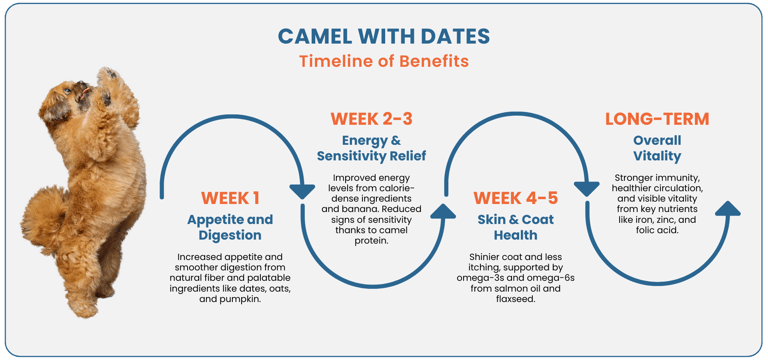Think of your dog's digestive system like your own. Just as you might have noticed certain foods don't agree with you anymore - perhaps that extra-hot curry that never bothered you in university now keeps you up at night - dogs can develop similar sensitivities over time.
When your dog shows signs like persistent scratching, recurring ear problems, or digestive issues, food sensitivity could be the culprit. Unlike an immediate allergic reaction that might send you rushing to the vet, food sensitivities often develop gradually, sometimes over months, which makes them particularly tricky to spot.
Also, your dog's digestion is as unique as your fingerprint, which means the solution must be personally tailored to their individual needs.
Understanding Food Sensitivities in Dogs
Understanding food sensitivities in dogs requires patience and careful observation but, once you know what to look for, you can make informed decisions about your dog's nutrition. Here's what every dog parent should know:
- The early warning signs often whisper rather than shout - from subtle paw licking to recurring ear infections that seem to have no obvious cause.
- Your dog's digestion is as unique as your fingerprint, which means the solution must be personally tailored to their individual needs.
- The path to better nutrition isn't about elimination alone - it's about building a foundation of wholesome, varied ingredients that support your dog's overall wellbeing.
.png?width=1200&height=800&name=Food%20sensitivities%20(1).png) Recent studies have revealed a striking increase in canine food sensitivities. Veterinary experts are now estimating that approximately 1-2% of dogs may be affected. As more dog owners become nutrition-conscious advocates for their dogs' health, we're seeing a shift from simply managing symptoms to addressing root causes through thoughtful dietary choices.
Recent studies have revealed a striking increase in canine food sensitivities. Veterinary experts are now estimating that approximately 1-2% of dogs may be affected. As more dog owners become nutrition-conscious advocates for their dogs' health, we're seeing a shift from simply managing symptoms to addressing root causes through thoughtful dietary choices.
This growing awareness also reflects our deepening understanding of how proper nutrition serves as both preventive care and a pathway to ideal health.
Many dogs develop sensitivities to common proteins like chicken, beef, and dairy—often the very ingredients that dominate commercial dog nutrition. This presents a genuine challenge: how to provide complete nutrition without triggering uncomfortable reactions?
How Novel Proteins Work
Novel proteins open up a world of possibilities for dogs with sensitivities. These unique protein sources work brilliantly because they're unfamiliar to your dog's immune system. Think of them as a fresh introduction - your dog's body hasn't developed any negative associations with these new protein sources. This means they can provide all the essential amino acids your dog needs for ideal health while avoiding the triggers that cause discomfort.
But not all novel proteins are created equal. The ideal sources combine:
- Minimal exposure in typical canine diets
- Complete amino acid profiles
- High digestibility
- Sustainable sourcing
Camel Protein as a Choice for Sensitive Dogs
Camel meat represents an exceptional choice for dogs with sensitivities, combining nutritional excellence with genuine novelty. This protein source is particularly relevant in the UAE, where camel has been valued for centuries but remains rarely used in conventional dog nutrition, making it particularly suitable for those with sensitivity issues.
By any standard, the nutritional profile of camel protein is impressive: it is packed with premium protein, naturally lean, and bursting with B vitamins and iron — exactly what dogs need in our warm climate. The amino acids support strong muscles and robust immunity, whilst being gentler on digestion than traditional protein sources.
What makes camel meat truly special is its unique molecular structure. When dogs struggle with common proteins like chicken or beef, camel meat often provides the perfect alternative. Their bodies recognise it as something different, allowing their digestive and immune systems to thrive without triggering those uncomfortable reactions.
Complementing Novel Proteins with Supportive Nutrition
While the protein source forms the foundation of an anti-sensitivity diet, complementary ingredients play crucial supporting roles. For example, our Camel with Dates recipe incorporates functional ingredients that work in harmony with this exceptional protein:
- Dates, which provide gentle fibre and help regulate digestive transit
- Oatmeal, offering easily digestible complex carbohydrates
- Pumpkin, supporting healthy digestion with soluble and insoluble fibre
- Salmon oil, contributing anti-inflammatory omega-3 fatty acids
This careful formulation ensures your dog receives complete nutrition while minimising potential triggers—a balanced approach to managing sensitivities without compromising overall health.
.jpg?width=1920&height=1080&name=Camel%20With%20Dates%20Nutrition%20(2).jpg)
Transitioning to a Novel Protein Diet
When introducing a novel protein-based nutrition plan, a gradual transition is essential. Start by replacing just a quarter of your dog's current meals with the new diet. Every 2-3 days, increase this portion until you've fully switched over—typically within 7-10 days. This gentle adjustment helps your dog's digestive system acclimatise comfortably.
Most dogs experiencing food sensitivities show noticeable improvement within 4-8 weeks on a properly formulated novel protein diet. During this period, we recommend keeping a simple diary tracking any changes in skin condition, digestive function, and overall well-being.

For dogs with severe or complex sensitivity issues, consulting with a veterinary nutritionist is advisable. They can help identify specific triggers and develop a customised nutrition plan — potentially including our Camel with Dates recipe — to address your dog's unique needs.
We take nutrition seriously. Every novel protein recipe undergoes rigorous testing with independent nutritionists to guarantee it meets the highest standards. However, don't simply rely on our word for it — the enhanced coat condition and revitalised bounce in dogs who were previously sensitive provide compelling evidence.
Remember, every dog responds differently to dietary changes. While some may adapt quickly, others need more time. The key is patience and careful observation—you know your dog best, so trust your instincts while following these guidelines.

.png?width=1200&height=800&name=Food%20sensitivities%20(1).png)
.jpg?width=1920&height=1080&name=Camel%20With%20Dates%20Nutrition%20(2).jpg)


